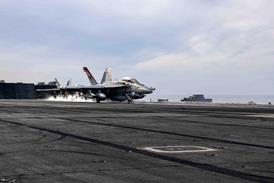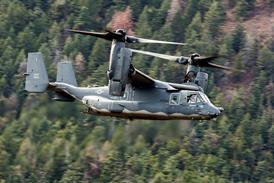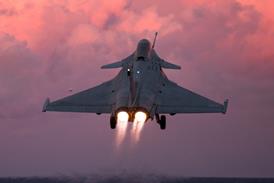Allan Winn/NAIROBI
If there hadn't been a KLM, I wouldn't have known what to do - we'd done all the things we could," says Kenya Airways managing director Brian Davies as he looks back over the months since a successful privatisation and the formation of a successful alliance with the Dutch flag carrier.
"It's almost like a second start - the first job finished on privatisation. I'm finding it very stimulating," he says.
The privatisation had seen 40% of the shares in Kenya Airways placed with overseas investors, KLM taking 26%. The management of the airline remained firmly in Kenyan hands, however: all but two of the board of directors, are senior local figures, and those other two are from the airline itself. The Government has only a 23% share now, and has said that it does not intend to put any more money in - according to Davies, it has no plans to divest, but is just waiting to see how the airline develops.
Davies, who first came to the airline on a contract with British Airways' Speedwing consulting arm, is one of just a handful on non-Kenyans in the company. After the consultancy had finished, he left, never expecting to come back - until he was invited to return as chief executive to implement Speedwing's recommendations.
DUTCH SURPRISE
With that background, it came as a surprise to many, when KLM emerged as the chosen strategic partner for the airline, but Davies, has no doubts that the Dutch carrier was the right choice. "They've given us access to a global network via Northwest, Air UK, Jet Airways in India and Garuda - they cover a broad spread," he says. "A small African airline could have no presence, for example, in the USA. What we provide them with is a hub in Africa."
Despite the shareholding, he says, KLM plays no direct part in running the airline. That is not to say that KLM is uninterested in Kenya Airways' progress. An Alliance committee meets monthly in either Amsterdam or Nairobi to make joint decisions, and there are detailed action plans in place to cover every alliance topic. There is a hope that the two airlines might merge their European sales offices. Davies says that KLM looks "-very closely at our financials", but already it can look on that aspect purely as an investment.
With a return on capital employed of around 25% and a nett margin on sales of 13.4% (in the most recent year, the company made a profit of 1.4 billion Kenyan shillings - $25 million - on a turnover of $170 million) Davies claims that it is a "reasonable" investment. As he puts it: "Africa has huge potential for profitable growth - with high-yield passengers, relatively low frequencies, and relatively poor ground infrastructure. There is still a period of high growth yet to come before the deregulation bites fully and yields drop." (In 1995, Kenya Airways carried about 800,000 passengers: 320,000 of those were domestic, 180,000 to Africa, 160,000 to Europe and 140,000 to the Middle East.) Part of the deal with KLM involved the Dutch company providing $3 million worth of services in kind to help with the alliance - for example with new computer systems.
In return, there are some very real benefits to come. Previously, KLM had a relatively fragmented operation to Africa - being able to focus that on Nairobi, as a hub should make it more efficient. What Kenya Airways should bring to that is a feed to the hub, getting an almost-guaranteed source of new customers in return. "By taking over what had been their old tail in services, we got good extra traffic using our [Boeing] 737s," says Davies. "There are also a couple of things we are doing that we didn't expect to, for instance, they offer a Nairobi-Lilongwe (Malawi) service but, as they don't have the traffic rights and we do, we do it for them," he says.
Also, KLM is short of aircraft this northern winter, so Kenya Airways will take over running one of its Amsterdam-Nairobi services with an Airbus A310 from November. In effect, one of the Kenya Airways London flights will go via Amsterdam, replacing one of KLM's four weekly flights with McDonnell Douglas MD-11s.
The two companies are looking at further co-operation in markets where each is already flying, although perhaps only at low frequencies, and still negotiating over some rights. For instance, they are talking to Egypt about joint operations through Cairo. "The point of this is to build enough thickness of the trunk - but to keep it balanced," says Davies. The end result should be an integrated network, but Davies concedes that it will be into 1997 before the full results - with through-checking and a common frequent-flier programme - will be seen.
The same sort of co-operation is envisaged in cargo operations, for instance through Dubai, which is a major cargo hub for KLM and already served by Kenya Airways. They are also looking at ways of developing a Nairobi cargo hub but, as with the passenger side, much depends on the development of Nairobi's Jomo Kenyatta airport. Nairobi is becoming a real hub: Air Zimbabwe and South African Airlines are the main two airlines which carry on further south, but operators like Air Tanzania and Uganda Airlines are also feeding into it. As Davies puts it: "The runway has bags of spare capacity, and so does the terminal - it's just a question of getting the funds and getting on with it."
The cargo discussions, Davies says, have included looking at the possibility of using dedicated freighters, but not immediately. "We are trying to see what we can squeeze out of belly holds - and, remember, KLM has a lot of Combis, too," he says.
Kenya Airways' own fleet is under review: it consists of three A310s, two Boeing 737-200s and three Fokker F50s. The backbone of its international services to places like Johannesburg, Harare, India and London/Amsterdam is its Airbus fleet. "We have just won an award for the highest utilisation of A310s in the world," says Davies. "They're eight to nine years old, so our next study is what we do - add more A310s, or go for something larger?"
MORE CAPACITY
He says that the London-Nairobi route is just about the optimum service for a fully loaded A310, so it would be difficult to improve on its efficiency, but "-if the market grows, we will need more capacity or more frequency". He adds that load factors are already reaching "...the low 80s" leaving little room for growth.
Davies sees an extra advantage to the Airbuses in that the company owns two of them outright, having made the last payment in September - the third is leased. "They are worth $30 million each, and we have the ability to use that equity, for example by sale and leaseback," he says, while adding that there are "-very generous" tax breaks in Kenya on capital purchases. That could have a big influence on future lease-or-buy decisions.
The carrier's two 737-200s are ex-Egyptair: while they are still performing well technically, Davies says they are falling behind in passenger acceptance. They will be replaced by two new -300s next year - one in arriving in March and one in May. Kenya Airways did look at the new-generation 737-700/-800 before buying the older -300 but, according to Davies:"-they are aircraft that fly further and higher, but we don't need that at this stage".
The 737s are used both internationally and on the major domestic routes, where they are mixed with the F50s in a reflection of the unusual make-up of the market. There are two distinct traffic streams - quite dense business traffic between the two main cities (Nairobi and Mombasa), and holiday makers. "The F50s are OK for business travelers, but not good for holiday makers with bags - so we're looking at whether a regional jet would make sense. At the moment on Mombasa, we put the 737 on at certain times of day, but during the low part of the day use the F50s," says Davies.
"We're also looking at whether we should do a 'Kenya Airways Express' to our other Kenyan destinations," he says. That might not be the only development inside Africa for the company. Davies says: "I think KLM is enough outside Africa, but we may need more links inside. There is a possibility of doing deals with other carriers that have gone through the same process that we have." That process has included changing the internal culture of the airline, much of it through courses in subjects such as customer service. The first course - "building pride together" - trained 2,700 people in 30 days. "Every single employee from the chief executive to the messenger went through the same course - nothing like that had ever been seen in the company," says Davies.
Not that everything in the company is rosy as a result. Davies admits that, while relations with the majority of pilots are good, "-there is a small group of political/militant union guys who continue to strive for the same pay rates as at BA or Air France or Lufthansa - but most recognise commercial realities. It set us back this year, but won't in the longer term. To deal with it immediately after privatisation slowed us up - and it didn't do the share price any good either." The omens for the future are, however, good.
Source: Flight International























